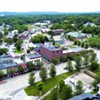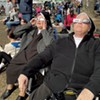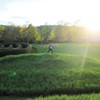Published November 30, 2005 at 1:25 a.m.
At first glance, the building at 47 West Spring Street in Winooski looks a lot like any retirement home. On the Wednesday afternoon before Thanksgiving, the walls are decorated with construction-paper-cutout turkeys and autumn-colored leaves made by the nurses.
A bingo game has been going since 2 p.m. in the main dining room; two blue aluminum walkers are parked outside the door. A disembodied woman's voice echoes in the front hall. "N 45," she says over the loudspeaker, "N, 4, 5."
Technically speaking, this is not an old-folks home -- it's the Our Lady of Providence Convent.
Sister Bibiane Crete, one of several nuns playing bingo, takes a break to give a reporter the grand tour. The spry, 76-year-old Quebec native wears a maroon polyester skirt and striped blouse -- those old black-and-white habits have been optional for decades. The only indication that she's married to Christ is the silver cross dangling from her neck.
Crete, who stands perhaps a hair less than 5 feet tall, has lived here for 31 years. As she flits through the chapel, with its bone-fragment relic of the convent's founder, to the stairwell, with an African batik of an all-black Last Supper, to the common room with the big-screen TV, she comments frankly, "Things are changing."
The biggest change over the years is the absence of anyone under 70. Like Catholic religious orders across the country, the Sisters of Providence are experiencing a recruitment and retirement crisis of astonishing proportions. It's been going on so long that it might seem like old news, but if the trend continues unabated, it will completely transform the next generation of American Catholic communities. Many convents and priories have already been forced to sell their buildings and merge with other orders. Nuns, monks and priests who once ministered to the poor and the sick have themselves become a population in need. And as more and more of their members pass from this life to the next, the ones who survive are watching their way of life gradually disappear. There are now just 191 nuns in 10 orders in Vermont, and their average age is in the seventies.
At its peak in the 1950s, Crete explains, her bustling, multigenerational Roman Catholic convent housed more than 50 Sisters of Providence. Many of them, like her, taught at Catholic schools, including the St. Francis Xavier grade school across the street. Their income helped pay for the cost of caring for the community's elderly.
Those days are long gone. Crete is the only nun still teaching, and she's cut back to part-time. Just a handful of sisters works outside the convent; those who are still able pitch in with chores such as dishwashing and staffing the business office.
Today, Our Lady of Providence Convent houses 42 women, just 22 of them Sisters of Providence. Faced with empty rooms and mounting bills in the 1990s, the convent opened its doors to nuns from other religious orders. Our Lady of Providence is now home to eight Sisters of the Religious Hospitaliers of St. Joseph, six Missionary Sisters of Our Lady of Africa, and one nun from the Sisters of St. Joseph order based in Rutland.
Lay people are also a relatively new addition. At one time, access to this religious community was rigidly restricted; even relatives weren't allowed to eat with the nuns. But seven years ago, the Sisters of Providence also began admitting secular women to their Winooski home who pay to stay -- it's a revenue source. Today, the Our Lady of Providence convent actually includes five such residents, and they all eat and live together like one big family -- "like a big family with a lot of old people," quips Crete.
Down in Rutland, the Sisters of St. Joseph are in similar straits. Sister Mary Polworth says they turned the convent into an assisted-living facility years ago, but can't recall exactly when. "Dates I can't pull out of my head," she admits over the phone. "I'm one of those aging." Recently Vermont's Sisters of St. Joseph order merged with their counterpart in Massachusetts.
Polworth joined the convent in 1952, when "There were three sisters working for every sister who was older," she recalls. "It's reversed -- or even worse -- now." Polworth reports that of 40 people who live in the convent, just 15 or 16 are nuns. "The lay people outnumber us now," she says, noting that, at 78, she may be the youngest nun there.
Ginny Cunningham, of the Washington, D.C.-based National Religious Retirement Fund, shares some more start- ling statistics. In the 1950s, she says, there were roughly 180,000 men and women in Catholic religious orders in the United States. They taught in Catholic schools, worked in Catholic hospitals, and staffed social-service agencies. Today, barely 13,000 men, and slightly more than 60,000 women, belong to religious communities.
Cunningham clarifies one crucial point -- those numbers do not include diocesan priests, who minister to specific parishes. Those priests are aging, too, a fact that has been widely reported in connection with parish closings all over the country. But the church has taken better care of them than it has of their religious brothers and sisters. Most diocesan priests have pensions, or receive retirement support from their dioceses. Members of religious communities, however, remain independent of the church, and rely solely on their orders -- and paltry Social Security checks -- to aid them as they age.
This creates cash-flow problems, especially for nuns, who earned pennies on the dollar compared to secular workers in the same jobs. Many nuns were not even part of the Social Security system until the 1970s.
As these religious men and women age, like everyone else they require increasingly expensive care. Currently, 6229 of them reside in assisted-living facilities, and another 6000 are in nursing homes throughout the U.S. Cunningham notes that this care costs, on average, $126 a day -- lower than the national average of $145 a day. But "You multiply that by almost 13,000, and you can see it's a humongous problem," she says. "Many orders just don't have the resources to handle that."
To ameliorate the crisis, four of the country's Catholic religious associations created the National Religious Retirement Fund, which sponsors an annual parish appeal. This year's collection will happen in churches nationwide on December 10 and 11.
For the past seven years, Cunningham has been the appeal project director. She says that people respond with overwhelming generosity to the fund, which raises, on average, about $28 million a year. Some of that returns to Vermont's 10 women's orders and two priories.
She says the sexual abuse scandal, which has diminished ordinary parish collections, "hasn't made a dent" in her fundraising. Most of the abuse claims have been filed against diocesan priests, and none of the religious orders has been sued. Cunningham suggests that most Catholics, regardless of how they feel about the issue, are still grateful for the work nuns have done.
Over the past 18 years, the fund has collected more than $460 million. Cunningham claims it costs less than that -- $400 million -- on an annual basis to care for the elderly in religious orders.
You'd never know from talking with the nuns at Our Lady of Providence that they're members of an endgangered species. Sister Bibiane, for example, is a cheerful and lively host.
Touring the convent's magnificent brick chapel, she explains in her rapid-fire speech that the nuns still gather here for vespers -- evening prayers -- five days a week. They have Saturday and Sunday free -- "free to go gallivanting," Crete jokes, then clucks her tongue disapprovingly. "You will cause a scandal, Bibiane," she mutters to herself.
When, at the end of the tour, she returns to the business office, she notices that one of the other sisters has made a mistake on a form. "Oh, I'm going to get someone in trouble," she cackles. "We're going to have a fight in the nunnery tonight!"
Crete credits her genial nature to her part-time job teaching French to first-, second- and third-graders at St. Francis. "It keeps me young," she says, a mischievous twinkle in her blue eyes. "Young and in a good mood."
She doesn't seem sad or bothered by the order's decline. "This is life," she says.
The sisters who pass in the corridors affect a similar disposition. Sister Olive Lettre stops to talk when Crete approaches. The 86-year-old nun makes herself comfortable on a chair at the back of her walker. She entered the convent in 1940, and taught at Catholic schools all over Vermont for 46 years before she retired. She admits to missing the uniform. "I loved my habit," she says. "Now you have to match everything, you know?" But she seems otherwise content. "I've been thankful," Lettre says with a sigh. "I've enjoyed my years."
Even Sister Carmen Proulx, the convent's Mother Superior -- or "coordinator," as she's now called -- is similarly, well, Zen. Proulx, 74, wears jeans and a short-sleeve plaid shirt over a black turtleneck, and her white sneakers are well worn. Proulx says she's not sure even she would choose to be a nun these days -- there are so many other ways to serve people, whether it's through the Peace Corps or community service.
Sister Mary Polworth of Rutland seems adaptable, too. "I guess I'm one of those people who doesn't fear change," she says. "In fact, I welcome it." Polworth "firmly believes" that religious life will always exist, though she's not sure what it will look like in the future.
If Vermont's Sisters of Mercy is any indication, it will almost certainly involve lay people. With 64 sisters, the state's largest order, isn't recruiting many young novices, either, but it's thriving nonetheless with the help of several dozen secular "associates." Male and female volunteers are assisting with the order's diverse portfolio of community-oriented programs that include sponsoring the Mater Christi grade school as well as educational activities for adults and programs for women in recovery and in prison.
Sister Ruth Ravey, the order's director of development, says the associates will ensure that the nuns' legacy continues. She says, "We see them as helping to pass on the message of mercy."
More By This Author
Speaking of...
-

'We're Leaving': Winooski's Bargain Real Estate Attracted a Diverse Group of Residents for Years. Now They're Being Squeezed Out.
May 1, 2024 -

Through Arts Such as Weaving, Older Vermonters Reflect on Their Lives and Losses
May 1, 2024 -

Soundbites: Waking Windows Returns
May 1, 2024 -

More Vermont Seniors Are Working, Due to Financial Need or Choice. They May Help Plug the Labor Gap.
Apr 17, 2024 -

The $200 Mystery: Anonymous Person Mails Cash to Multiple Winooski Residents
Apr 15, 2024 - More »
Comments
Comments are closed.
From 2014-2020, Seven Days allowed readers to comment on all stories posted on our website. While we've appreciated the suggestions and insights, right now Seven Days is prioritizing our core mission — producing high-quality, responsible local journalism — over moderating online debates between readers.
To criticize, correct or praise our reporting, please send us a letter to the editor or send us a tip. We’ll check it out and report the results.
Online comments may return when we have better tech tools for managing them. Thanks for reading.











































